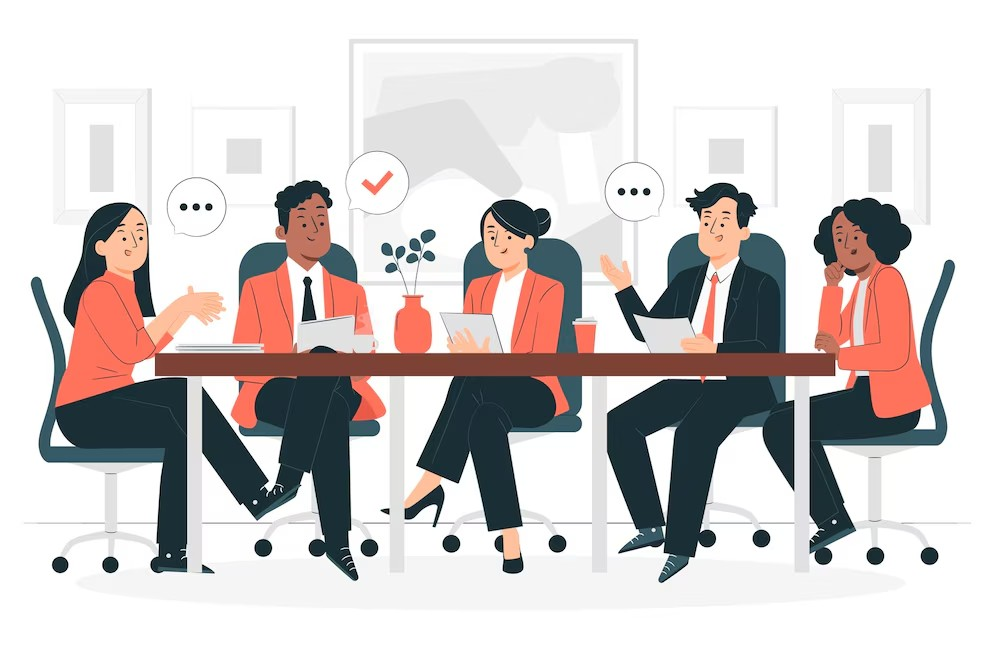11 tips for good meeting etiquette
Follow these standard rules for proper meeting etiquette:
1. Be punctual
In meeting etiquette Being on time for meetings shows maturity, professionalism and courtesy to the rest of the meeting attendees. Leaders want their meetings to run efficiently, so eliminating distractions associated with lateness is an essential step in this process. Outside of the workplace, arriving a bit late for social events or appointments may be fine, but in professional settings, it is usually expected participants arrive on time. Coming a few minutes early is even better so you can sit and get situated before the meeting begins. If you do find yourself running late to a meeting, apologize to everyone, have a seat and focus on the discussion right away.
2. Come prepared
Many meeting organizers send emails with a rundown of the agenda, especially if it’s a meeting with many people and several topics the organizer wants to discuss. An agenda will ensure the meeting runs smoothly and efficiently. They may also ask that attendees bring materials to take notes with, come with suggestions or ideas regarding a topic or complete an assignment before the meeting. Make sure you come fully prepared with anything the organizer requires.
3. Dress professionally
Depending on the nature of your office, the appropriate attire may vary. Follow the dress code rules your office enforces for in-office meetings. If you are meeting a client outside of the office, the same rules usually apply, but you may want to ask your manager what the appropriate attire is if you have uncertainties.
4. Speak loud enough
When you speak during the meeting, make sure to speak loudly and clearly so everyone can hear you. This portrays confidence and makes you look more professional. It also ensures everyone hears your thoughts and can respond accordingly. Soft speaking can affect the meeting’s efficiency if you need to repeat yourself or someone mishears you.
5. Actively listen and participate
Meeting productivity relies on participants listening well to others and actively participating in discussions. You could practice active listening by nodding or paraphrasing what the other person is saying to show understanding, expressing your concern or asking specific, probing questions. In addition to showing the person that you respect their opinion and want to hear what they say, active listening helps you stay focused and offer more meaningful responses.
6. Take turns speaking
Business meetings sometimes create exciting and passionate conversations where everyone wants to give their input. The best thing to do is wait for your turn to speak and allow others to finish their thoughts before jumping into the conversation. Follow any speaking rules the facilitator has, such as raising your hand. Also, write down your main points if you think you might forget what you want to say while waiting, but try to continue listening to the conversation while writing.
7. Follow the agenda
Staying on topic is good business etiquette because it reduces time wasted on tangents. Business meetings sometimes go off the agenda, but it’s helpful to the facilitator if you stay on task and keep the meeting productive. If you can, lead the conversation back to the original topic if you notice it drifted to an unrelated subject.
8. Ask questions at the appropriate time
The best time to ask questions is during the presentation at opportune moments when your question is relevant to the presenter’s information. Be courteous and wait for a break in their speech to raise your hand. They will also likely invite attendees to ask questions periodically during the presentation. Try to avoid asking all of your questions at the very end when the meeting needs to wrap up. If you have unanswered questions at the end, you could stay to ask them privately or send an email to the meeting leader.
9. Be attentive to your nonverbal cues
It’s easy to get restless during long meetings. Try to avoid the following habits:
- Tapping pens
- Fidgeting
- Swivelling your chair side to side
- Tapping your feet
- Rustling papers
- Making quiet noises like humming or clicks
Though harmless when at your desk, these behaviours can distract presenters and listeners and may give them the impression you aren’t interested.
10. Put away technology
Many people tend to keep their phones on the table during meetings, but this may become a distraction if it accidentally rings, buzzes or lights up. Turn off or silence your device, then put it away where it is no longer visible, such as in a purse, briefcase or jacket pocket. You may want to bring paper and a pen to take notes and avoid the distraction of technology. However, if you need to refer to information on your laptop, check with the organizer to see if it’s appropriate to bring it along.
11. Eat and drink appropriately
Usually, water and coffee are acceptable to drink during meetings, but check if food is OK to bring. Often, the smell of food and chewing sounds can distract others, so it’s likely best to leave the food for after the meeting. If it’s a lunch meeting, eat quietly and respectively. Also, always clean up and leave your seat as you found it.
4: Meeting Etiquette Rules
Pre-meeting
1. Choose the best time for everyone.
2. Find the right room for your meeting size and equipment needs.
3. Make (and follow) an agenda.
During the meeting:
4. Show up on time.
5. Know what you’re responsible for.
6. Introduce folks who are new or calling in.
7. Mute yourself when you’re not speaking in a video conference.
8. Pay attention!
9. Have a good posture.
10. Share the conversation.
11. Speak loudly and clearly.
12. No eating or drinking (besides water or coffee).
Post Meeting:
13. Ask questions at the appropriate time.
14. Thank everyone for attending and presenting.
15. Follow up with required deliverables with Minutes of Meeting.
References:


